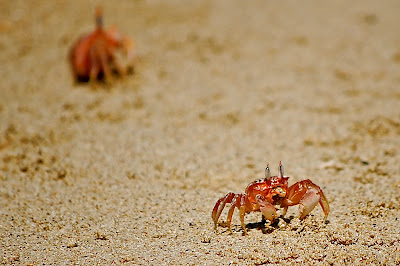Photos of flora and fauna from a week in the Galápagos -- the islands of Santa Cruz, Santa Fe, and Plazas Norte. Notes accompany photos, though the pictures themselves look better in slide-show format. Click on any photo to kickstart the slide-show. Enjoy!
 |
| Cactus Finch feeding |
 |
| Medium Ground-finch (most likely!), with courtship display |
 |
| Galapagos Mockingbird |
 |
| Marine Iguana |
 |
| Black-winged Stilt |
 |
| Whimbrel |
 |
| Spiny Galapagos Tree-slug -- not the official name, just a guess |
 |
| Fishing Lava Heron |
 |
| ...with his catch |
 |
| Galapagos Tortoise, from the Charles Darwin Research Center |
 |
| Prickly Pear Cactus tree -- food and shade for the endemic land tortoises |
 |
| Baby tortoise |
 |
| Smooth-billed Ani |
 |
| Pair of Galapagos Mockingbirds |
 |
| Yellow Warbler -- the Galapagos variety lacks the red streaking of the North American kind, it's the only warbler on the archipelago. |
 |
| Galapagos lava lizard, male displaying |
 |
| Lava Gull |
 |
| Spotted Manta? |
 |
| Black-winged Stilt |
 |
| Lava Gull |
 |
| Magnificent Frigatebird |
 |
| White-vented or Eliot's Storm-petrel |
 |
| Sea lion, or lobo (wolf) in Spanish -- to me, the canine name is much better. Sea-lions are the Labs of the sea. |
 |
| Playing with string... another couple was playing with a crab. Most are juveniles playing in a protected inlet while the "beach master" male patrols, on the lookout for Galapagos sharks. In a fight between an adult sea lion and Galapagos shark, I'd give it to the sea-lion 9 out of 10 times, said Eddy, our guide. |
 |
| Swallow-tailed Gull on Plazas Norte, nesting |
 |
| Galapagos Land Iguana |
 |
| No tail? No dice. This iguana obviously didn't make it. Sometimes the sea lions nip them off, or they may lose one fighting with a rival male. |
 |
| Cactus flower |
 |
| Blue-footed Booby |
 |
| Brown Noddy, or Noddy Tern |
 |
| Galapagos Shearwater, actually a member of the Puffin family |
 |
| Red-billed Tropic-bird |
 |
| Nesting Noddies |
 |
| Pile of Marine Iguanas -- the one in the center is not climbing; he's just hanging out like that. |
 |
| Limited shade, lobo and iguana share it |
 |
| Cactus Finch -- the ID is in the shape of the beak, it's one of the easier of Darwin's Finches to ID. |
 |
| Swallow-tailed gull eggshell |
 |
| Nursing sea lion |
 |
| Just off shore you could see the 10' Galapagos Sharks patrolling the bay, waiting for a hapless juvenile to wander too far out. There has been one surfer fatality in the last year (off the Island of Santa Cruz) due to the Galapagos Shark. |
 |
| Galapagos Dove |
 |
| Mockingbird with a moth |
 |
| Riptide warning on a popular surf beach with a Brown Pelican |
 |
| Endemic, the Galapagos Flycatcher |
 |
| Cattle Egrets |
 |
| Don't know what kind of crab this is, but we called it the strong-arm. Only the right claw is big (and red). |
 |
| Ruddy Turnstone |
 |
| Stilt |
 |
| White-cheeked pintail |
 |
| Snowy Egret |
 |
| Likely Medium Ground-finches -- it's said that "only God and Peter Grant can identify Darwin's Finches." The beak and body-sizes of some, including the medium and large, overlap. |
 |
| Returning to Puerto Ayora |
 |
| The island of Daphne Major -- famous site for evolutionary biology as the Grant team has studied the variations and observable evolution of its finches for generations, since 1971. |
 |
| Cactus Finch |
Complete, conservative bird list:
Red-billed Tropicbird
*Cactus Finch
*Lava Heron
Smoot-billed Ani
Great Blue Heron
Brown Pelican
Magnificent Frigatebird
Yellow Warbler
*Swallow-tailed Gull
*Galápagos Shearwater
Brown Noddy
Nazca Booby
Great Egret
Snowy Egret
Cattle Egret
Blue-footed Booby
Whimbrel
*Medium Ground-finch
White-vented Storm-petrel
Yellow-crowned Night-heron
*Galápagos Dove
*Galápagos Flycatcher
*Galápagos Hawk
*Lava Gull
White-cheeked Pintail
Ruddy Turnstone
Semipalmated Plover
Endemic species are *'d













































































No comments:
Post a Comment